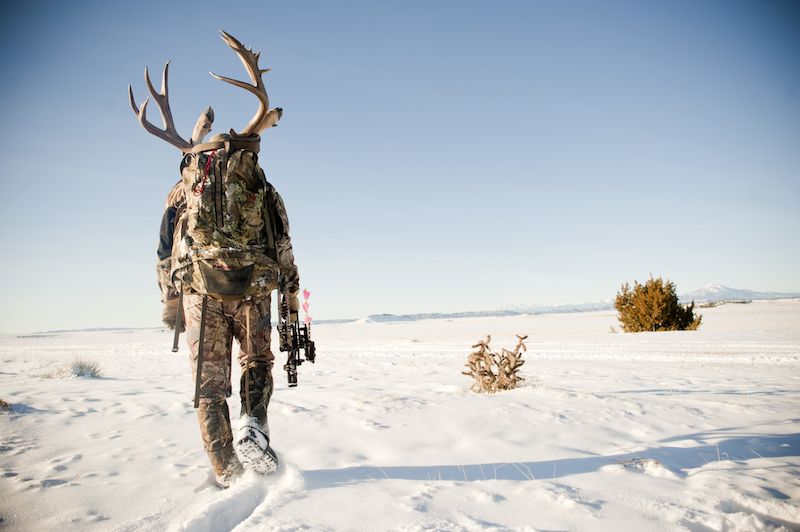Deer don’t look at calendars or schedules to decide when to hunker down to wait out hunting season. No matter the week or month, they must eat and rest every day while trying to survive. That’s why the early bow season has no more meaning to deer than the late season.
Hunting pressure, or lack thereof, affects their daily behavior. In fact, the late archery season often means less hunting pressure and hungrier, more active deer. If you haven’t punched your tag, the weeks ahead can be a prime time to bowhunt.
Follow this 5-step plan to find deer, choose your setup, and give yourself the best chance at success.
Food is usually abundant in the early season, but becomes scarce in the late season. Therefore, every late-season food source becomes a hot commodity and bowhunting hotspot. When you find those foods, check for fresh sign, including tracks, trails, droppings and pawed areas where deer scratched for their meals. Once you know deer are around, move to Step 2.
Not sure what food sources to look for? Click here to understand how a whitetail’s diet changes with the seasons, and where you can find late-fall and winter food sources.
Next, determine how deer travel to their food sources. When deer aren’t eating, they’re resting. Locate their bedding areas and try to identify travel routes to and from the food. Using an aerial photo or topographical map, draw a line between deer sign, food sources, and bedding areas.
Reuben Frey, a bowhunter from Charleston, Illinois, recommends using trail cameras and glassing sessions to pinpoint bedding areas. Frey has bowhunted 11 years and likes late-season hunting because “deer are back on a food-to-bed pattern.” Those patterns make them more predictable and easier to target.
Frey said deer usually bed in thick, remote areas with ample sunlight and little human activity. Does often bed in family groups, but mature bucks bed by themselves, usually with cover at their back and wind blowing from behind. Such setups let them smell possible threats from behind while watching for danger ahead.
Deer aren’t nocturnal, they’re crepuscular. That means they’re most active during the twilight of dawn and dusk. Therefore, deer feed more heavily at night and rest during the day. That’s why Frey sets up near food for late-afternoon and early-evening bowhunts to catch deer as they travel from bedding areas to food sources. In contrast, he hunts the edge of bedding areas in the morning to catch deer returning from food sources.
He said south-facing slopes are good bets for late-season bedding areas because they absorb direct sunlight, which melts frost and warms the air.
“Deer like to sit in the sunlight to keep warm after feeding,” Frey said. “Much of their daytime movement also occurs in these types of areas. They might get up and move short distances to browse on surrounding food or just to stretch their legs.”

You’ve spent many days in the woods at this point, so don’t give up now. Photo Credit: John Hafner
Fireplaces, furnaces and heavy blankets tempt bowhunters to stay indoors during the late season, but you can’t arrow deer from your living room. Successful bowhunters stick to their stands, increasing their chances.
“Perseverance and a good attitude are key in the late season,” Frey said. “Days can be cold and uneventful, but if you do your homework, you can figure out where [deer will be] during shooting hours. Change your setup when things don’t pan out, and keep at it.”
Bowhunters must be flexible and adapt to be productive. Change your strategies as deer change their food sources or travel patterns.
“The deer are still there,” Frey said. “You just have to adjust your strategy to get on them. Don’t be afraid to move often. Stay on fresh intel [and] keep switching it up.”
Always look for fresh sign, and study deer behavior to find hot sites for your treestands. Frey suggests scouting after each fresh snowfall. Snow highlights deer tracks, and shows where they’ve been and where they’re going.
To effectively hunt changing food sources and deer patterns, use a climbing treestand. These portable, comfortable stands are easy to set up and take down as you react to feeding activity.

Ask a fellow hunter for tips if you’ve never hunted this late in the season before. Photo credit: John Hafner
– Bundle Up: Bowhunting in December and January can be cold. Stay warm by dressing in layers, and using air-activated hand- and foot-warmers. Frey pairs hand-warmers with a mitten muff to keep his trigger finger hot.
“You don’t want to be locked up when you need to draw back on the deer you’ve been chasing all season,” Frey said. Read Bowhunting 360’s article “Bowhunters: You Can Stay Warm in Cold Weather” for layering techniques and other tips.
– Seek Advice or Help: Learning to hunt is easier than ever, thanks to technology and great online resources. If you’re unsure about your late-season strategy, seek help. The Bowhunting 360 community on Facebook and Instagram is a welcoming source of ideas, answers and hunting advice.
Frey said social media provide great ways to share stories and bowhunting strategies with like-minded bowhunters. That’s why he and three friends created CRAM Outdoors on Instagram and YouTube in 2008.
“Getting involved in these networks can help you keep a beat on what’s happening in the woods and on the water, including late-season bowhunting strategies for deer,” Frey said.
For more late-season hunting tips, read these Bowhunting 360 articles:
– 6 Tips to Help You Bag a Late-Season Buck